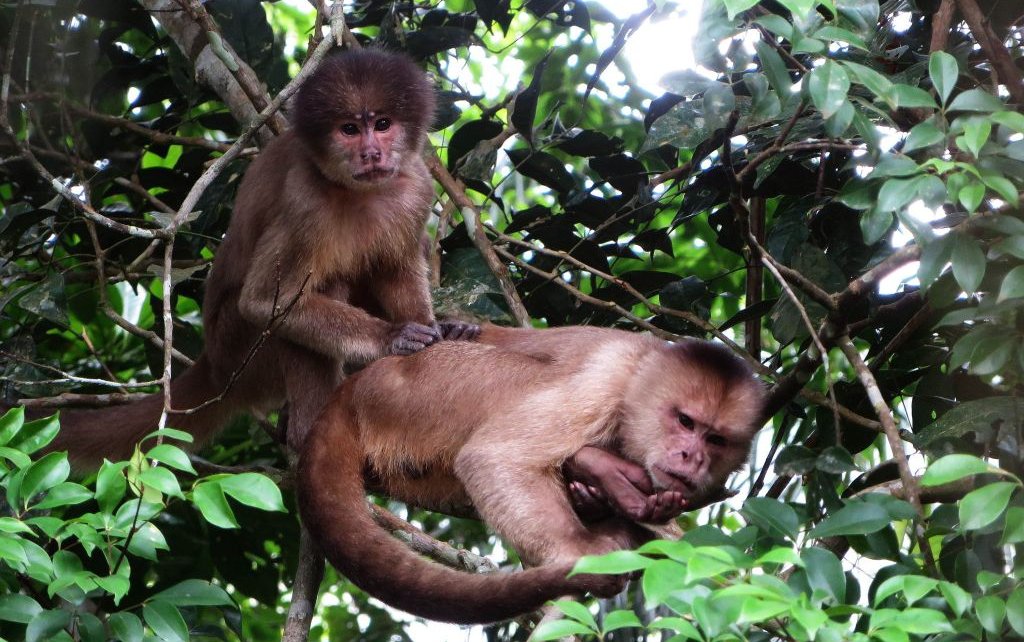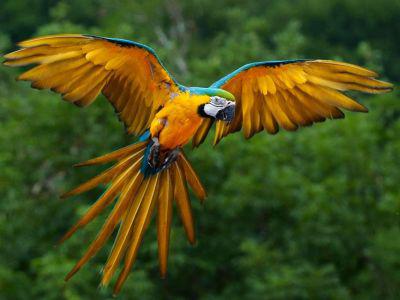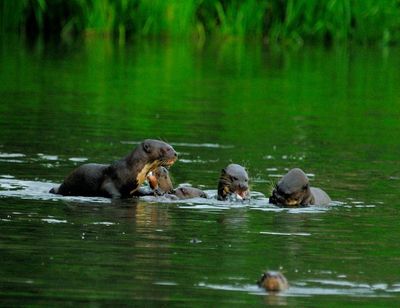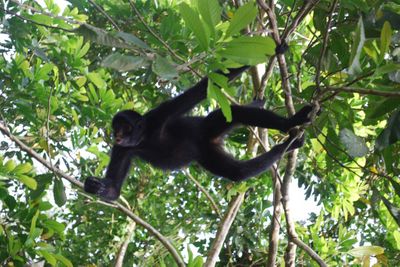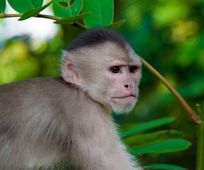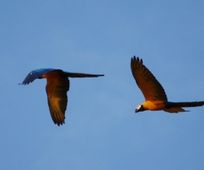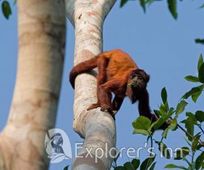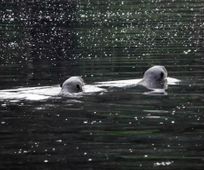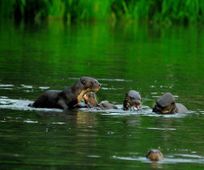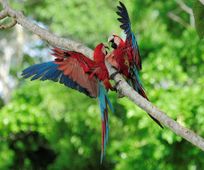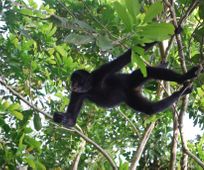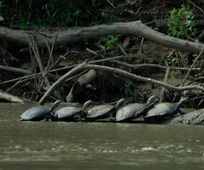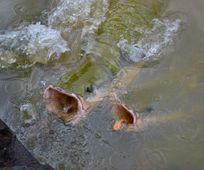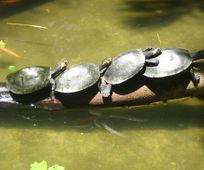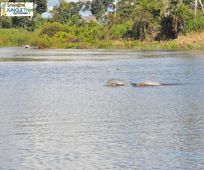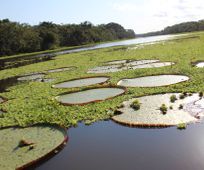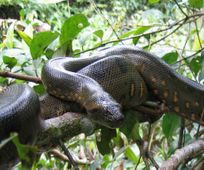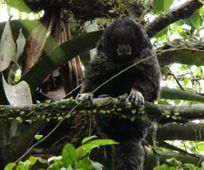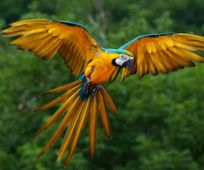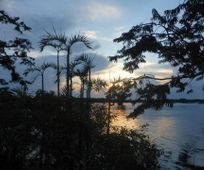Information about the Amazon Rainforest
This page provides you with more information about Nature reserves in the Amazon Rainforest of Ecuador, Peru and Bolivia including:
- the Madidi National Park, Bolivia
- the Beni Biosphere Reserve and Serere Sanctuary, Bolivia
- the Tambopata Candamo Reserve and Bahuaja-Sonene National Park in Peru
- the Manu (Biosphere) Reserve, Peru
- the Amazon of Iquitos Pacaya Samiria National Reserve, Peru
- the Cuyabeno Wildlife Reserve and Yasuni National Park in Ecuador
Madidi Amazon Reserve
The PN (Parque Nacional) Madidi was created in 1995. The Madidi Amazon Reserve is located in the Northwest region of the Department of La Paz, in the provinces Franz Tamayo, Iturralde and Abel Bautista Saavedra and can be reached from Rurrenabaque if you cross the Beni River with the small passenger ferry over to San Buenaventura.
The Madidi Amazon Reserve covers 18,957.5 km2 (1,895,740 ha) and forms part of the international corridor of protected areas that extends from Vilcabamba (in Peru) to Amboro (in Bolivia), including Manu Biosphere Reserve, Tambopata-Candamo Reserve, Bahuaja-Stonene National Park y Manuripi-Heath, Apolobamba. All together this forms one of the largest protected areas and most biologically diverse regions in the world.
The Madidi nature reserve ranges from the Amazonian lowlands of the rivers Heath and Tuichi, at 200 m altitude, to the mountains of the glacier-covered Apolobamba Range at more than 6,000 m altitude. Madidis vast wilderness has a variety of ecosystems and encompasses unparalleled biodiversity ranging from mountain cloud forest to dry tropical forest, humid lowland forest to savanna, wild rivers and lakes!
Madidis mountains, forests and river habitats are home to more than 1,000 species of neotropical birds, 5,000 – 6,000 superior plants, 44% of all new world species of mammals, and an estimated 38% of neotropical amphibians. The tropical Andes from Madidi is also a globally critical hotspot of plant endemism.
Inside the Madidi park’s limits you will find the community of San Jose de Uchupiamonas, of the Quechua-Tacana ethnic group.
The ecosystems are protected in three reserves – Madidi National Park (Amazon Rainforest, incl. the Yungas and montande dry forest), Pilon Lajas Biosphere Reserve and Indigenous Territory (Amazon rainforest) and the Pampas Reserve (Beni savannas).
Wildlife
Dr. Robert Wallace, wildlife biologist, is credited for discovering an unidentified titi monkey which only lives in Madidi, a new species to science. The right to name the new species was auctioned through an agreement between the scientists, the Bolivian National Protected Area Service (SERNAP) and the Foundation for the Development of the Protected Areas (FUNDESNAP). This effort has raised 650,000U$ for a trust fund which now generates enough income to pay for 14 park guards annually. The park is also notable for its over 1,000 bird species, representing 11% of the world’s 9,000 bird species.
Equivalent there is a rich and varied life in the water with many fish species.
Note: During a survey in October 2011, done with the support of National Geographic they discovered 19 different jaguars in the Madidi Amazon Reserve!
The weather
The climate varies from cold in the mountain range area until warm in the lowlands of the North. The dry season coincides with the austral winter. The average annual temperature is 26 C degrees, but much depends on the altitude.
Madidi is located in the southern hemisphere and so the cold season (autumn and winter) go from May to September and the hot seasons (spring and summer) from October to the beginning of April, it’s also considered the rainy season.
Warmest month November, wettest month January.
Eco Amazon Lodges
There are also some eco-lodges in and around the Madidi National Park. The oldest and best known is Chalalan Ecolodge in Chalalán on the Tuichi River, a successful community-based enterprise that generates significant economic benefits to indigenous communities.
Another important site is the Serere Sanctuary operated by Madidi Travel; a 4000 hectare private reserve dedicated to generating income through real sustainable eco-tourism for on-going conservation work to establish new legally protected zones in the north of the Madidi Mosaic. Its creator Rosa Maria Ruiz is a woman who has fought for the Madidi Park and its conservation for over 20 years. She was the founder of Eco-Bolivia, an organization that was instrumental in establishing Madidi National Park in the 1990s. The Serere lodge is located three hours from Rurrenabaque by boat.
Others Amazon lodges include San Miguel del Bala Eco-Lodge on the banks of the Beni River reached by boat 40 minutes upstream from Rurrenabaque, and the young Entno Ecolodge – Mashaquipe on the Tuichi River close to the outlet into the Beni River.
The Tambopata (Candamo) National Amazon Reserve
Both the Tambopata National Reserve and the Bahuaja-Sonene National Park form part of the titanic 30 million hectare Vilcabamba-Amboro Conservation Corridor.
This corridor is formed by 16 protected areas ranging from the Vilcabamba mountain range west of Cusco, to the Amboro National Park in central Bolivia, and include Manu National Park, the Machu Picchu Historical Sanctuary and the Madidi National Park, among others. In addition, this corridor protects over 40 ethnic groups. Its objective is to spur the region’s development through participatory planning for the strengthening of local organizations, sustainable small businesses and agro-forestry in order to minimize the loss of biodiversity.
Tambopata National Amazon Reserve (formerly only known as the Tambopata-Candamo Reserved Zone) is a nature reserve in the Peruvian Amazon Basin south of the Madre de Dios River and north of Puno in the Tambopata Province’s Inambari and Tambopata districts. The Tambopata Amazon Reserve has a surface area of 1,478,942 hectares (3,654,550 acres) and was created on January 26, 1990, to protect the watersheds of the rivers Tambopata, Candamo and Heath.
Access to the reserve is from Puerto Maldonado, where one can get to the preserve via the Tambopata River; or by car via the Cuzco - Puerto Maldonado road.
The Tambopata Amazon Reserve features eight life zones: subtropical humid forest, tropical humid forest, subtropical high-humidity forest, subtropical high-humidity foothills cloud forest, subtropical rainforest, tropical cloud forest foothills, subtropical lower foothills cloud forest and semi-flooded subtropical cloud forest.
Flora and fauna
The Tambopata Amazon Reserve also has two important ecosystems that are noted for its biodiversity, representing a great variety of flora and fauna. The impressive list of discoveries so far includes: 165 species and 41 families of trees, over 10,000 species of vascular plants, 1,234 types of different butterflies, 592 bird species, 32 parrot species (10% of the world’s total), 127 species of amphibians, over 10 different monkey species and 103 species of mammals in general, 74 reptiles, etc.
Rare fauna found in the Tambopata Reserve includes: the jaguar and other wild cats, the giant otter, over 10 monkey species, the black caiman, white-lipped peccary, tapirs and more!
Amazon Lodges
Many of the Amazon jungle lodges in the Tambopata Reserve belong to a network of organizations and communities that are attempting to protect this amazing wilderness of Tambopata by creating an alternative income and awareness for its beauty.
Note: Most Jungle Lodges are NOT situated in the new less accessible part of the Tambopata National Reserve, the so called Reserved Zone. To provide better protection to this Zone there is only a limited amount of lodges and visitors allowed in the area. The most known and popular Amazon Lodge in the Reserved Zone is the Tambopata Research Center, located close to the famous Colpa macaw clay-lick.
Population:
Less than 5000 people (equivalent to a minor league sports event) inhabit the Tambopata National Reserve’s “area of influence” to the north. Most of them make a living of slash and burn agriculture, small scale gold mining, timber extraction, and hunting and fishing.
There is a tribe of about a thousand people called the ‘Esse’eja’ o ‘huarayos’ that live in the reserve, in four titled communities within this area of influence. They live next to the Quechuas and Aymaras and have activities such as agriculture (coffee), hunting, fishing and foraging.
Weather
Rainy season is from November to April. Dry season runs from May to October and from July to September is the best season to observe macaws.
Average annual temperature is 26°C, ranging from 10-38°C; with average annual rainfall of 1600–2400 mm. Rainfall in the protected area is typical of most areas in the Peruvian Amazon. The climate is humid and (3000 mm and 25°C on average), sub-level humidity and semi-warm (1700 mm and 26°C on average), high-level semi-warm (4000 mm and 23°C).
Manú National Amazon Park
The Manú National Park is a biosphere reserve located in Madre de Dios and Paucartambo, Cusco. The park encompasses virtually the entire watershed of the Manú River, from the sources of its tributaries high in the Andes, to its emptying into the Madre de Dios River.
Before becoming an area protected by the Peruvian government, the Manú Amazon Reserve was conserved thanks to its inaccessibility. The park remains fairly inaccessible by road to this day.
As the surrounding area is largely undeveloped, the only direct access to the lowlands is by boat, up the Manú River. This singular entry point is easily patrolled by park guards. The road Cusco-Paucartambo-Shintuya borders the southern section of the park and provides access to high-Andean ecosystems, such as grasslands (puna) and montane forest and scrub.
In 1977, UNESCO recognized it as a Biosphere Reserve and in 1987, it was pronounced a World Heritage Site. The Manu Park is the largest National Park in Peru, covering an area of 15,328 km². The Biosphere Reserve includes an additional 2,570 km², and a further 914 km² are included in the so called “Cultural Zone” (which also affords a level of protection), bringing the total protected area up to 18,811 km².
The Manu Amazon Park protects several ecological zones ranging from as low as 150 meters above sea level in parts of the Southwest Amazon moist forests to Peruvian Yungas at middle elevations to Central Andean wet puna at altitudes of 4200 meters. Because of this topographical range, it has one of highest levels of biodiversity of any park in the world.
Flora in Manu
More than 20,000 species of plants are found in Manú, and up to 250 varieties of trees have been found in a single hectare! 40% Of the park is Amazonian lowland tropical rainforest, including varzea, oxbow lakes, Iriartea palm swamps, and upland forest types.
Fauna in Manu
The Manu reserve is a dream destination for birdwatchers from all over the world, as it is home to over 1000 species of birds, more than the number of bird species found in the United States and Canada combined!
The Manú Biosphere Reserve has a very rich wildlife and claims as having one of the highest abundances of land vertebrates ever found in Latin American tropical forests.
Larger species of the lowland forests include jaguar, puma, ocelot, giant otter, giant anteater, southern tamandua, giant armadillo, nine-banded armadillo, brown-throated sloth, Hoffmann’s two-toed sloth, Brazilian tapir, capybara, pacarana, Wild Tayra , Andean cock-of-the-rock, lowland paca, collared peccary, white-lipped peccary and several deer species, like South American red brocket, and South American brown brocket. The marsh deer, actually rather a savannna animal, has also been confirmed. There are 14 species of monkeys. These are Goeldi’s marmoset, pygmy marmoset (the smallest monkey in the world), the, shock-headed capuchin (Cebus albifrons cuscinus), tufted capuchin (Cebus apella peruanus), Brown-mantled tamarin, emperor tamarin, moustached tamarin, black-capped squirrel monkey, black-headed night monkey, brown titi, Rio Tapajós saki, Bolivian red howler, Peruvian spider monkey, and gray woolly monkey.
Confined to the mountainous areas above 2000 m altitude is habituated by the the Peruvian white-tailed deer, dwarf brocket, culpeo, mountain paca, spectacled bear and the puma.
Short list of animal species categorized in the Manu Amazon Reserve: 222 mammals species; 99 reptile species; 140 amphibian species; 1000 bird species; 210 fish species; 1307 butterfly species; 136 dragonfly species.
Because of Manu’s low human population and their continued use of traditional hunting techniques, the animals in the park show little fear of man and are more readily approachable than in many other rainforest locations. Manu, therefore, offers unparalleled animal watching opportunities.
Wildlife aside, however, the journey into the park itself is amazingly spectacular and not to be missed. Access to Manu is normally by road from Cusco, Peru. The two day trip from Cusco to the entrance of the Manu Reserved Zone carries you over the Peruvian Andes mountains to an elevation of 4000 m, past pre-Inca ruins and down through the cloud forest on the eastern side of the Andes, and finally into lush, lowland rainforest. Roads remain largely unpaved and wind their way precariously past cascading waterfalls, deep gorges, and precipices. Manu is truly a complete experience.
Humans in the Manu park:
Permanent human habitation is restricted to several small communities of the Matsigenga Amazonian tribal group, largely along the Manú River or one of its main tributaries. Within the heart of the Manu Biosphere even remain yet un-contacted indigenous tribes!
Several protected areas adjoining the park allow mixed use including tourism, hunting, logging, and harvesting of other resources. These areas, notably downstream on the Manú River, are included in the broader Manú biosphere reserve, but are not part of the national park.
The Cocha Cashu Biological Station, under the guidance of renowned Duke University ecologist John Terborgh is the largest and most established research site in the park, and is among the most-studied sites for biological and ecological research in the tropics.
The Manu Learning Centre (MLC) lies within the Cultural Zone of the Manu Biosphere Reserve along the South-Eastern border with the Alto Madre de Dios River. The MLC facilitates research work within the disturbed ‘buffer’ zone of the park where human impact is higher.
Weather
Most of this rain falls from the end of November through beginning of April. The dry months of the year are from June to September.
Amazon, Iquitos – Pacaya Samiria National Reserve
“The Jungle of the Mirrors”
Amazon River
The mighty Amazon River is at 6,470 km (4,020 miles) long the world’s longest and largest river.
Navigating the Amazon River is getting in direct contact with the nature and lore of the natives that live there, it is watching the sun setting behind the treetops and marveling at the endless greenery. The Amazon is an immense slow moving river, at times almost like an ocean, as at certain points it can reach up to 4,000 meters in width. Its waters receive the outflow of all the rivers rising on the eastern slopes of the Andes, forming swamps, marshes and labyrinthine channels.
The ancient peoples of the Peruvian Amazon jungle call the Amazon River, Paranaguasú (Great River), Paranatinga (White River) and Tunguragua (King of the Waters). It is also claimed that the name is the result of a combination of two native words, ama (break) and zona (canoe); thus Amazon could mean “Canoe-Breaker” or Amazon (female) Warior.
Iquitos
Many towns and villages have formed along the banks of the Amazon River, the most important being Iquitos capital of the department of Loreto.
The waters around Iquitos are known for the great possibility of seeing the pink/ white fresh water dolphin, the grey dolphin and the enormous Victoria water lilies.
Victoria is a genus of water lilies, in the plant family Nymphaeaceae, with very large green leaves that float on the water’s surface. Victoria Amazonica has a leaf that is up to 3 m (9.8 ft) in diameter, on a stalk 7–8 m (22.9-26.2 ft) in length. The genus name was given in honor of Queen Victoria of the United Kingdom.
The Amazon Basin itself has the longest extension of rainforest in the world and is considered a patrimony of humanity by UNESCO due to the biological diversity it contains. The beauty of this area, as well its biological richness, have made of Peru a destiny for wildlife researchers and nature lovers.
Pacaya Smiria Amazon Reserve
In 1982, the Peruvian Government established the Pacaya Samiria National Reserve with the purpose of preserving the wilderness resources and the beautiful landscapes of the area. The Reserve has an area of 8,042 square miles, which represents 1.5% of the total surface of Peru and is located at 180 Km. (115 miles) of Iquitos.
The name of Pacaya Samiria comes from the names of two rivers that run through it: Pacaya and Samiria. The Amazon Reserve is part of the National System of Natural Areas and is protected by the Peruvian Government. Its administration is in hands of INRENA (National Institute of Natural Resources) which has offices in Lima and Iquitos. According to the Master Plan for the Conservation of the Biological Diversity and Sustainable Development of the Pacaya Samiria National Reserve, tourists have access only to determined zones of the Reserve -previous payment of an entrance fee.
Flora in Pacaya Samiria
In Pacaya Samiria, you can find more than1.204 plant species. This diversity is caused partly by the fact that a great extension of rainforest remains flooded during most of the year. The species include local species like the “aguaje”, a palm tree (Mauritia flexuosa) whose fruits are eaten by many animals as well as by settlers of local communities.
There are other numerous varieties of flora that make the landscape of the Reserve unique in this part of the Amazon. We can also find a great diversity of medicine plants and trees that can reach a height of 150 feet, like the “lupuna” (Ceiba pentandra). In certain areas, you can still find rubber trees which preserve the marks of the famous rubber exploitation over 80 years ago.
Wildlife in Pacaya Samiria
The wildlife of the Reserve is also typical for the flooded rainforest, being more abundant the aquatic species rather than land ones. An essential element that is characteristic of this protected area and its inhabitants is the cycle of crescent and reflux of the rivers.
Fish is considered the most important resource due to its role in the ecological process as well as its economic value, and it is also a priority in the nutrition of the local people. There is an extensive variety of birds, specially the aquatic ones like the heron (Egretta thula) and cormorant (Phalacrocorax brasilianus). During the time of crescent, the high areas or “restingas” are the places for shelter and nourishment for mammals. The variety of animal species you can find in the Pacaya Samiria Amazon Reserve include: 449 bird species, 102 mammal species, 69 reptile species, 58 amphibianspecies, and 256 fish species.
Threatened or endangered species that can be found in the Pacaya Samiria National Reserve are the jaguar (Felix oca), the black alligator (Melanosuchus niger), the giant river otter (Pteronura brasiliensis), the manati (Trichechus inunquis), four different species of primates and two different species of turtles.
It is worth mentioning the “charapa” (Podocnemis expansa) and “taricaya” (Podocnemis unifilis) acquatic turtles, which are considered endangered species. In order to prevent any illegal gathering, between the months of July and December, authorities of the Pacaya Samiria National Reserve are responsible for the gathering of the eggs that the turtles deposit in the banks of the rivers allowing these eggs the proper incubation time and a better chance of survival for the little turtles. Also, the “paiche” (Arapaima gigas), one of the biggest fresh-water fish in the world, that can reach up to eight feet long. The demand for its exquisite meat has developed in an abuse for its hunting.
Humans in Pacaya Samiria
In the Pacaya Samiria National Reserve there are 94 communities, 21 of them of the Cocama – Cocamilla ethnic group. The total population of the Reserve is 42,000 people and their main economic activities are centered around fishing, agriculture, gathering and hunting, being the first, their most important activity and main source of food. The closest towns to the Reserve are Nauta and Requena.
Weather and water seasons
Rainy season is between October and April. The water of the rivers and creeks increases during these months, flooding a large area of the rainforest. This phenomenon is known as crescent. Reflux takes place between May and September, when rain decreases greatly and the level of the water falls progressively, reaching its minimum in August. This seasonal change and the predominantly flat terrain have configured a landscape full of small rivers, creeks and lagoons.
Wildlife adapts with no problem to this cycle of crescent and reflux and so, when most of the rainforest remains flooded, animals find shelter in the highest areas, where water never reaches.
During the reflux, when water is retained in small lakes and creeks, you can observe a large number of aquatic birds catching fishes which are concentrated there. During this time, large beaches are also formed especially in the main rivers, which are used by the settlers of the Reserve to grow rice, beans, peanuts, and other crops.
Reflux is also an important time of the year for two characteristic species of the Pacaya Samiria Reserve, the “charapa” (Podocnemis expansa) and “taricaya” (Podocnemis unifilis) acquatic turtles, which use these beaches to lay their eggs.
Cuyabeno Wildlife Reserve
The Cuyabeno Wildlife Amazon Reserve (in Spanish: Reserva de Producción Faunística Cuyabeno) is a humid tropical rainforest reserve in Ecuador. Cuyabeno is situated in the Putumayo Canton in the Sucumbíos Province and in the Aguarico Canton in the Orellana Province and was founded on 26 July 1979.
At an altitude of 200– 280 meters, one of the principle objectives of the 6,033.8 square kilometres (2,329.7 sq mi) Cuyabeno Reserve is ongoing conservation of the complex Amazonian ecosystem. The flora and fauna from the Cuyabeno Reserve isn’t only protected by the Ecuadorian government, but also by its geographical nature and location.
The reserve holds an extensive complex of rivers, creeks, lagoons and floated forest, which makes the area difficult to work for the wood and petroleum industries.
The protected area from Cuyabeno is characterized by its high biodiversity and interaction and cooperation between the species inhabiting the area. Its geomorphology is a consequence of the rivers carrying sediment and materials from the Andes, principally by Aguarico River, which is considered as white water due to the sediment it drags.
Cuyabeno is considered to be one of the most bio diverse sites in the world together with the neighboring Yasuni National Park.
Approximately 12000 different plants have been found inside the Cuyabeno Amazon Reserve, including as palms, bromeliads, Ceibos, heliconia, Macrolobium, wild roses and 60 different orchid species. Many of these plants are still used by the native indigenous to eat, build and cure diseases.
Wildlife in Cuyabeno
The Cuyabeno reserve is particularly known for its wildlife. Creatures like tapirs, ocelots, bats, jaguars, pumas, capybaras, anacondas, anteaters, peccaries, poison dart frogs, agoutis, iguanas and fifteen different species of monkey can be found roaming the extensive lands of the reserve. Swimming through the waters are turtles, pink freshwater dolphins, giant otters, manatees (use to be frequent, but are now very rare seen), five species of caiman and over 350 different species of fish—including the famous piranha.
And if you look into the air and search the tree-tops you can find more than 550 different bird species, which make this reserve a great place for bird watching! Keep your eyes peeled for colorful parrots, kingfishers and hoatzins, woodpeckers, hummingbirds, tanagers, macaws, toucans and even the Harpy Eagle, which flaunts its 8-foot (2.4 m)-wide wingspan!
Amazon experience
Visitors to the Cuyabeno region will be stunned by the remoteness of it. The jungle appears as a thick, dense mass of green laced and interwoven by powerful rivers and trickling streams. Life is all around you at the Cuyabeno reserve, as you’ll notice that it’s never quiet here. You can always hear something buzzing, chirping, howling or hooting. Green is without a doubt the dominant color, but the longer you spend at the park, the more you will begin to notice the brilliant flashes of color produced by the many exotic flowers, birds and insects.
Visitors to the area should also be prepared to get wet, and not just from the torrential rains and overflowing rivers. The humidity level is typically between 90 and 100%, making for some very sticky conditions. Be sure to pack breathable clothing and plastic casing for any electronics or valuable goods.
Humans in Cuyabeno
The five different ethnic groups that still live within the reserve include: the Siona, Secoya, Cofán, Kichwas and Shuar. Each of them still has its own culture and language.
Weather in Cuyabeno
The extensive Cuyabeno water system covers the Aguarico River, the San Miguel River and the Cuyabeno River, all of them with their own tributaries.
Limited rainfall records indicate an annual mean precipitation of about 3,000 mm; with more than 250 mm of monthly rainfall during the rainy season (from mid-March through August) and less than 250 mm during the dry season (from Mid-December through the first days of March).
During raining season floods from the Cuyabeno River form 14 typical black-water lagoons, which shrink a lot during the dry season. From December to March they might even dry almost out. During this period access to the lagoons is very unreliable and sometimes only possible on foot.
However, during the dry period, the lake area is extremely beautiful and wildlife often is concentrated in great numbers around the last remaining puddles and pools in the drained lakes. Many birds have their breeding season during that period.
Yasuni National Park
Yasuni National Amazon Park is in Ecuador and covers an area of 9,820 km2 mainly primarily rain forest between the Napo and Curaray rivers in the Napo and Pastaza provinces. Yasuni is about 250 km from Quito and was designated a UNESCO Biosphere Reserve in 1989. It is within the claimed ancestral territory of the Huaorani indigenous people. The Yasuni Amazon Reserve is also still home to several un-contacted indigenous tribes, including the Tagaeri and the Taromenane.
Yasuni is arguably the most biologically diverse spot on Earth. A single hectare in Yasuni boasts more species of trees than in all of North America!
Yasuni is at the center of a small zone where amphibian, bird, mammal, and vascular plant diversity all reach their maximum levels within the Western Hemisphere. Moreover, the park breaks world records for local-scale (less than 100 km2) tree, amphibian, and bat species richness, and is one of the richest spots in the world for birds and mammals at local scales as well. A species of bat, Lophostoma Yasuni, is endemic to the park.
However, Yasuni National Park is threatened by oil extraction and the colonization, deforestation, illegal logging and unsustainable hunting that has been made easier with the arrival of oil-access routes.
Fairtravel4u
Jan van Gentstraat 35,
1755 PB Petten, Nederland
(0031) (0) 622849262
Amazon-rainforest-tours.org
is part of Fairtravel4u and organises fairtravel tours through Ecuador, Peru and Bolivia.
Recommended by The Footprint, thé manual for backpackers.
© Fairtravel4u 2018 All Rights Reserved
